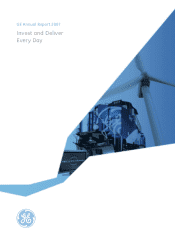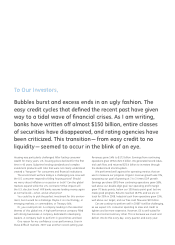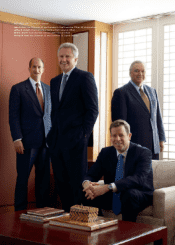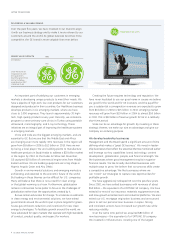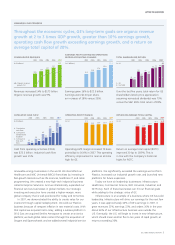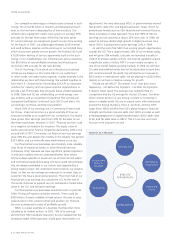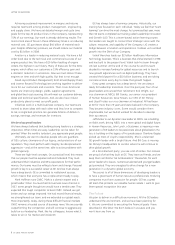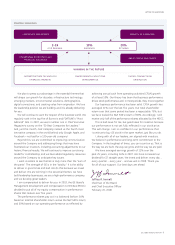GE 2007 Annual Report Download - page 10
Download and view the complete annual report
Please find page 10 of the 2007 GE annual report below. You can navigate through the pages in the report by either clicking on the pages listed below, or by using the keyword search tool below to find specific information within the annual report.Achieving sustained improvement in margins and returns
requires teamwork among product management, engineering,
and supply chain. We have set detailed margin and cycle time
goals for the top 30 product lines in the Company, representing
75% of our earnings. Our work is already delivering results. The
most critical area of focus in these infl ationary times is on reducing
material cost. GE purchases about $40 billion of material each
year. Despite infl ationary pressure, we should reduce our material
cost by $1 billion in 2008.
Aviation is a leader in reducing material costs. We have a full
order book due to the technical and commercial success of our
engine product line. We have a $19 billion backlog of engine
orders, the highest in our history. Many of these are for the GEnx
engine, which offers our customers a 15% effi ciency gain and
a dramatic reduction in emissions. Now we must deliver these
engines on time and with high quality. But that is not enough.
David Joyce (Product Management), Scott Ernest (Supply Chain),
and Jeanne Rosario (Technology) are working together to deliver
more for our customers and investors. Their cross-functional
teams are improving design, yields, supplier agreements,
and global best-cost sourcing. We will meet our customer delivery
dates and technical specifi cations. And, we also have robust
productivity plans to meet our profi t goals.
Initiatives work in a multi-business company. Our teams are
trained to share ideas with each other and they love to compete.
At GE, a single best practice can generate billions of dollars in
savings, earnings, and revenues for investors.
We develop great leaders
We have always believed that building strong leaders is a strategic
imperative. When times are easy, leadership can be taken for
granted. When the world is turbulent, you appreciate great people.
Ultimately, we want to develop people who are guardians
of GE’s culture, champions of our legacy, and protectors of our
reputation. They must perform with integrity, be disciplined and
aggressive — and at the same time, able to solve problems with
global ingenuity.
These are high-level concepts. On a practical level, this means
that our people must be experienced and motivated. They must
understand their industries and GE’s expectations for their perfor-
mance. Our teams must be willing to learn and change. Personal
growth is key to a successful career at GE. And we must always
have a deep bench. GE is committed to institutional success,
which means that everyone has a replacement ready to play.
Mark Hoffman runs CNBC. Mark is a domain expert and a
great leader. When Fox launched its business news channel in
2007, some people thought we would have a terrible year. They
expected this tough competitor to beat CNBC. Instead, we got
better and our ratings improved. We had record fi nancial results,
we strengthened our team, and we extended our global reach.
More importantly, today, during these diffi cult fi nancial markets
CNBC remains a trusted source of business news. We are soundly
outperforming the competition and will continue to aggressively
build on our leadership. Mark, like his colleagues, knows what it
takes to win in his market and inside GE.
GE has always been a learning company. Historically, our
training has focused on each individual. Today we feel that “team
learning” can drive the most change. As I promised last year, more
than 50 teams completed our training called Leadership Innovation
and Growth (LIG). This is a team-based, action-learning course.
Our leaders are taught to connect their strategic vision with the
culture, resources, and capability of the Company. LIG creates a
bridge between innovation and operations. It allows us to embed
growth into the DNA of our Company.
Vishal Wanchoo leads our $2 billion Healthcare Information
Technology business. This is a business that Vishal started in 1998
and has built to the present level. Vishal took his team through
LIG last summer. At the end of the course he and his team
decided to increase funding for global resources and to launch
new growth adjacencies such as digital pathology. They have
created the blueprint for a $10 billion business, and are taking
concrete actions every day to make that growth happen.
Every great company has a deep bench. We are always
ready for leadership transitions. Over the past year, four of our
great leaders announced their retirement: Bob Wright, our
vice chairman at NBCU; Bill Conaty, our senior vice president
of Human Resources; Dave Nissen, our CEO of GE Money;
and Lloyd Trotter, our vice chairman at Industrial. All had been
at GE for more than 25 years and were beloved in the Company.
They became industry icons. Some would consider them
irreplaceable, but we had all worked for decades to develop
their successors.
Jeff Zucker is our dynamic new leader at NBCU. He is building
on Bob’s work, driving NBCU into a more global and digital future.
In Human Resources, John Lynch, a Scotsman, is inspiring a new
generation of GE leaders to be passionate about globalization. He,
too, is building on the legacy of his predecessor. Charlene Begley
picked up most of Lloyd’s responsibility. She is a talented
GE growth leader with a bright future. And Bill Cary is moving
GE Money’s headquarters to London where he will continue to
drive global growth.
At a GE retirement party, you see a lot of smiles. Our retirees
are proud of what they built at GE. They leave as friends, and we
keep them as lifetime “GE Ambassadors.” Meanwhile, for each
senior leader who leaves, numerous talented and younger leaders
get promoted. They are energized to drive change for a new
generation in a dynamic global economy.
The secret to all of these dimensions of developing leaders is
to have a great team of human resource professionals. Enduring
companies must have a passion for people. GE has a great
HR team that protects our valuable human assets. I want to give
them special recognition this year.
The Future
We plan to deliver in a diffi cult environment. All the GE leaders
understand the environment, and we have been planning for
it. We are committed to executing the fi nancial goals I have
described in this letter. We don’t believe in excuses, and you
won’t hear any from us.
8 ge 2007 annual report

